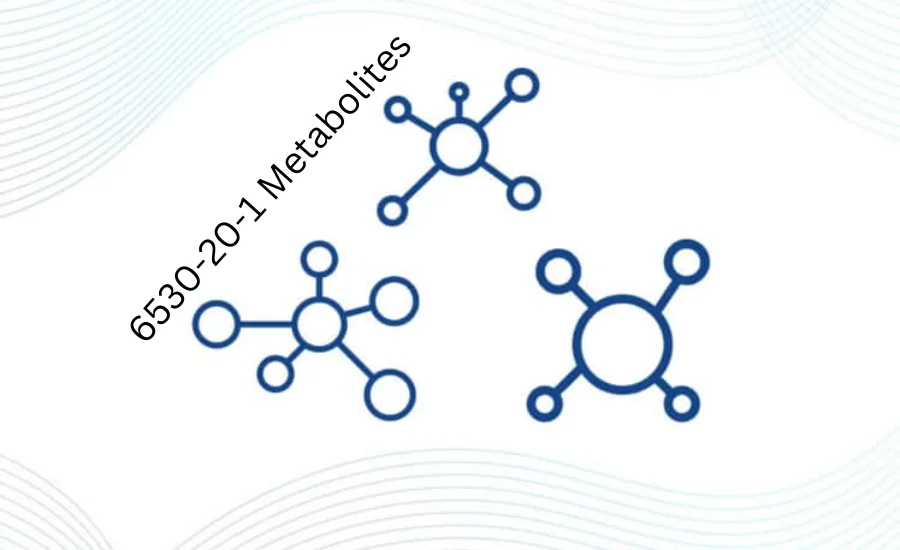6530-20-1-Metabolites: A Comprehensive Guide
Introduction
In the ever-evolving world of biochemistry and pharmacology, understanding chemical compounds and their derivatives is crucial for advancing both research and practical applications. One such compound that has gained significant attention in recent years is 6530-20-1-metabolites. As the name suggests, this compound plays a pivotal role in metabolic processes, and its study has opened up new avenues in drug development, toxicology, and clinical diagnostics.
This blog aims to provide a comprehensive overview of 6530-20-1-metabolites, exploring their chemical properties, biological significance, and potential applications. Whether you are a researcher, a healthcare professional, or simply someone with an interest in biochemistry, this article will serve as a valuable resource for understanding the importance of 6530-20-1-metabolites in the scientific landscape.
What Are 6530-20-1-Metabolites?
6530-20-1-metabolites refer to a group of chemical compounds that are produced as a result of metabolic reactions involving the parent compound 6530-20-1. Metabolism, a fundamental process in all living organisms, involves the conversion of substances into more manageable or excretable forms. In this context, 6530-20-1-metabolites are the byproducts formed when the parent compound undergoes enzymatic reactions within the body.
The study of 6530-20-1-metabolites is essential for understanding how drugs are processed in the body, how toxins are detoxified, and how various biochemical pathways are regulated. These metabolites can be detected and analyzed using advanced techniques such as mass spectrometry, nuclear magnetic resonance (NMR) spectroscopy, and chromatography, making them invaluable tools in modern science.
The Chemical Structure of 6530-20-1-Metabolites

Understanding the chemical structure of 6530-20-1-metabolites is crucial for grasping their biological functions and interactions. Typically, these metabolites retain some of the structural features of the parent compound, 6530-20-1, but with modifications that make them more polar, allowing for easier excretion from the body.
The chemical structure of 6530-20-1-metabolites often includes functional groups such as hydroxyl, carboxyl, and amino groups, which are introduced through enzymatic reactions. These modifications can alter the compound’s solubility, reactivity, and overall biological activity. By studying the structure of these metabolites, scientists can predict their behavior in biological systems and design drugs that either mimic or inhibit their actions.
Biological Significance of 6530-20-1-Metabolites
6530-20-1-metabolites play a significant role in various biological processes, including detoxification, energy production, and signal transduction. These metabolites can serve as biomarkers for diagnosing diseases, monitoring drug therapy, and assessing exposure to environmental toxins.
For instance, the presence of specific 6530-20-1-metabolites in the blood or urine can indicate how effectively a drug is being metabolized and eliminated from the body. This information is crucial for determining the appropriate dosage and avoiding adverse drug reactions. Additionally, the study of 6530-20-1-metabolites can provide insights into the mechanisms of drug resistance, paving the way for the development of more effective therapies.
Applications of 6530-20-1-Metabolites in Drug Development
One of the most significant applications of 6530-20-1-metabolites is in the field of drug development. Understanding how a drug is metabolized in the body is crucial for predicting its efficacy, safety, and potential side effects. By studying 6530-20-1-metabolites, researchers can identify the active and inactive forms of a drug, as well as any toxic byproducts that may be produced during metabolism.
This knowledge can be used to optimize drug formulations, improve therapeutic outcomes, and minimize adverse effects. For example, if a particular 6530-20-1-metabolite is found to be toxic, researchers can modify the drug’s structure to prevent its formation or enhance its elimination from the body. Similarly, if a metabolite is found to be the active form of the drug, efforts can be made to increase its production through metabolic engineering.
6530-20-1-Metabolites in Toxicology
The study of 6530-20-1-metabolites is also critical in toxicology, where it helps to assess the safety and potential hazards of chemicals and drugs. By analyzing the metabolites of a compound, toxicologists can determine how it is processed in the body and identify any harmful byproducts that may accumulate.
For instance, certain 6530-20-1-metabolites may bind to cellular components, causing damage and leading to toxic effects. Understanding these interactions is essential for developing strategies to mitigate toxicity and protect human health. Moreover, the identification of specific 6530-20-1-metabolites as biomarkers of exposure can aid in the early detection of poisoning and guide appropriate medical interventions.
6530-20-1-Metabolites in Clinical Diagnostics

In the realm of clinical diagnostics, 6530-20-1-metabolites serve as valuable indicators of metabolic status and disease progression. The presence or absence of certain metabolites can provide clues about the underlying biochemical pathways that are disrupted in various conditions.
For example, elevated levels of specific 6530-20-1-metabolites in the blood may indicate a metabolic disorder, such as inborn errors of metabolism or mitochondrial dysfunction. Conversely, a deficiency in certain metabolites may suggest a nutritional deficiency or a problem with nutrient absorption. By measuring 6530-20-1-metabolites, clinicians can diagnose diseases, monitor treatment effectiveness, and adjust therapeutic strategies accordingly.
Analytical Techniques for Studying 6530-20-1-Metabolites
The study of 6530-20-1-metabolites relies on advanced analytical techniques that allow for the detection, identification, and quantification of these compounds. Some of the most commonly used methods include mass spectrometry (MS), nuclear magnetic resonance (NMR) spectroscopy, and chromatography.
Mass Spectrometry (MS): MS is a powerful technique that measures the mass-to-charge ratio of ions to identify and quantify metabolites. It is highly sensitive and can detect even trace amounts of 6530-20-1-metabolites in complex biological samples.
Nuclear Magnetic Resonance (NMR) Spectroscopy: NMR spectroscopy provides detailed information about the structure and dynamics of metabolites. It is particularly useful for studying the chemical environment and interactions of 6530-20-1-metabolites in solution.
Chromatography: Chromatographic techniques, such as high-performance liquid chromatography (HPLC) and gas chromatography (GC), are used to separate and analyze mixtures of metabolites. These methods are often coupled with MS or NMR for enhanced detection and identification of 6530-20-1-metabolites.
Challenges in Studying 6530-20-1-Metabolites
Despite the advancements in analytical techniques, studying 6530-20-1-metabolites presents several challenges. One of the main difficulties is the complexity of metabolic networks, where multiple enzymes and pathways interact to produce a wide range of metabolites. This complexity makes it challenging to isolate and identify specific 6530-20-1-metabolites, particularly when they are present in low concentrations.
Additionally, the stability of 6530-20-1-metabolites can vary, with some compounds being prone to degradation or transformation during sample preparation and analysis. This requires careful optimization of experimental conditions to ensure accurate and reproducible results.
Another challenge is the interpretation of metabolomic data, where the biological significance of 6530-20-1-metabolites must be carefully assessed. This often requires integrating data from multiple sources, such as genomics, proteomics, and transcriptomics, to build a comprehensive understanding of the metabolic processes involved.
Future Directions in 6530-20-1-Metabolite Research

The study of 6530-20-1-metabolites is a rapidly evolving field, with new discoveries and applications emerging regularly. As technology continues to advance, researchers are likely to gain deeper insights into the roles of these metabolites in health and disease.
One promising area of research is the use of 6530-20-1-metabolites as therapeutic targets. By modulating the levels or activity of specific metabolites, it may be possible to treat a wide range of diseases, from metabolic disorders to cancer. Additionally, the development of new analytical techniques and computational tools is expected to enhance the detection and interpretation of 6530-20-1-metabolites, leading to more personalized and effective treatments.
Conclusion
In conclusion, 6530-20-1-metabolites represent a fascinating and important area of study in biochemistry and pharmacology. Their roles in metabolic processes, drug development, toxicology, and clinical diagnostics make them invaluable tools for advancing our understanding of human health and disease.
As research in this field continues to grow, the potential applications of 6530-20-1-metabolites are likely to expand, offering new opportunities for improving patient outcomes and developing innovative therapies. By staying informed about the latest developments in 6530-20-1-metabolite research, scientists and healthcare professionals can continue to push the boundaries of what is possible in modern medicine.
Whether you are a researcher, clinician, or simply someone with an interest in the biochemical sciences, understanding 6530-20-1-metabolites is essential for staying at the forefront of scientific innovation. With ongoing advancements in technology and a growing body of knowledge, the future of 6530-20-1-metabolites research holds great promise for improving health and well-being worldwide.






